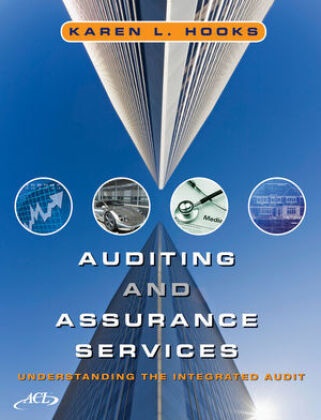Share
Fr. 385.00
Karen L Hooks, Karen L. Hooks, Kl Hooks
Auditing and Assurance Services Understanding the Integrated Audit Wse - Understanding the Integrated Audit
English · Hardback
Shipping usually within 1 to 3 weeks (not available at short notice)
Description
Klappentext Principles of Auditing presents auditing from the perspective of an integrated audit complying the Sarbanes Oxley Act (SOX), under the standards of the Public Companies Accounting Oversight Board. It is the first textbook completely authored after SOX, and consequently uses the integrated audit model throughout. In addition, this text also facilitates an understanding of audits of non-public companies. A primary focus is the need for auditors to understand their clients and their industries. Highlighted illustrative industries include: health care providers, retail enterprises, the automotive industry, and the land development and home building industry. Zusammenfassung Principles of Auditing presents auditing from the perspective of an integrated audit complying the Sarbanes Oxley Act (SOX), under the standards of the Public Companies Accounting Oversight Board. It is the first textbook completely authored after SOX, and consequently uses the integrated audit model throughout. Inhaltsverzeichnis INTRODUCTIONChapter 1 An Introduction to AuditingAppendix 1 Working in a CPA FirmChapter 2 Overview of an Integrated AuditTHE AUDIT ENVIRONMENTChapter 3 The Auditor's Role in SocietyChapter 4 Legal Environment Affecting AuditsEXECUTING AN INTEGRATED AUDITChapter 5 Client Acceptance and Continuance and Preliminary Engagement ProceduresAppendix 1 Industry DescriptionsAppendix 2 Audit Committees and Corporate GovernanceChapter 6 Audit Planning and Risk AssessmentAppendix 1 Using the Work of OthersChapter 7 Internal Control, Understanding the Client's Internal Control Over Financial Reporting and Auditing Design EffectivenessAppendix 1 Specifics of IT General ControlsAppendix 2 Enterprise Risk Management Integrated FrameworkAppendix 3 Internal Control over Financial Reporting in Smaller Public CompaniesChapter 8 Planning and Testing Operating Effectiveness of Internal Control over Financial ReportingAppendix 1 Testing IT Application Controls and Computer Assisted Audit SoftwareAppendix 2 Statistical Techniques and Tests of ControlsChapter 9 Substantive Procedures and the Financial Statement AuditAppendix 1 Statistical Techniques and Tests of Details of BalancesChapter 10 The Revenue Cycle Process and Related Accounts: Sales, Billing and Collection in the Health Care Provider and Retailing IndustriesChapter 11 Completing the Integrated Audit and ReportingAppendix 1 Non-Public Company AuditsADDITIONAL TRANSACTION CYCLES AND OTHER TOPICSChapter 12 The Acquisition and Payments Cycle and Related Accounts: Purchases, Cash Disbursements and Other Related Activities in the Automotive IndustryChapter 13 The Human Resources Cycle Process and Related Accounts:Personnel and Payroll in Service IndustriesAppendix 1 An Engagement to Issue a Report on the Processing ofTransactions by a Service Organization for Use by Other AuditorsChapter 14 The Inventory Cycle and Related Accounts: Trackingand Costing Products in the Land Development and Home Building IndustryChapter 15 Assets, Liabilities and Equity Related to the Financing CycleChapter 16 Topics Beyond the Integrated Audit...
List of contents
INTRODUCTIONChapter 1 An Introduction to AuditingAppendix 1 Working in a CPA FirmChapter 2 Overview of an Integrated AuditTHE AUDIT ENVIRONMENTChapter 3 The Auditor's Role in SocietyChapter 4 Legal Environment Affecting AuditsEXECUTING AN INTEGRATED AUDITChapter 5 Client Acceptance and Continuance and Preliminary Engagement ProceduresAppendix 1 Industry DescriptionsAppendix 2 Audit Committees and Corporate GovernanceChapter 6 Audit Planning and Risk AssessmentAppendix 1 Using the Work of OthersChapter 7 Internal Control, Understanding the Client's Internal Control Over Financial Reporting and Auditing Design EffectivenessAppendix 1 Specifics of IT General ControlsAppendix 2 Enterprise Risk Management Integrated FrameworkAppendix 3 Internal Control over Financial Reporting in Smaller Public CompaniesChapter 8 Planning and Testing Operating Effectiveness of Internal Control over Financial ReportingAppendix 1 Testing IT Application Controls and Computer Assisted Audit SoftwareAppendix 2 Statistical Techniques and Tests of ControlsChapter 9 Substantive Procedures and the Financial Statement AuditAppendix 1 Statistical Techniques and Tests of Details of BalancesChapter 10 The Revenue Cycle Process and Related Accounts: Sales, Billing and Collection in the Health Care Provider and Retailing IndustriesChapter 11 Completing the Integrated Audit and ReportingAppendix 1 Non-Public Company AuditsADDITIONAL TRANSACTION CYCLES AND OTHER TOPICSChapter 12 The Acquisition and Payments Cycle and Related Accounts: Purchases, Cash Disbursements and Other Related Activities in the Automotive IndustryChapter 13 The Human Resources Cycle Process and Related Accounts:Personnel and Payroll in Service IndustriesAppendix 1 An Engagement to Issue a Report on the Processing ofTransactions by a Service Organization for Use by Other AuditorsChapter 14 The Inventory Cycle and Related Accounts: Trackingand Costing Products in the Land Development and Home Building IndustryChapter 15 Assets, Liabilities and Equity Related to the Financing CycleChapter 16 Topics Beyond the Integrated Audit
Product details
| Authors | Karen L Hooks, Karen L. Hooks, Kl Hooks |
| Publisher | Wiley, John and Sons Ltd |
| Languages | English |
| Product format | Hardback |
| Released | 16.04.2010 |
| EAN | 9780471726340 |
| ISBN | 978-0-471-72634-0 |
| No. of pages | 960 |
| Subjects |
Social sciences, law, business
> Business
> Individual industrial sectors, branches
Rechnungswesen, Revision, Accounting, Auditing, Revision (Wirtsch.) |
Customer reviews
No reviews have been written for this item yet. Write the first review and be helpful to other users when they decide on a purchase.
Write a review
Thumbs up or thumbs down? Write your own review.

